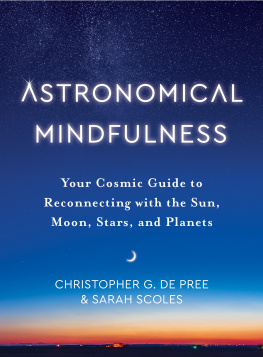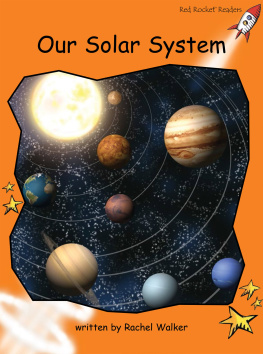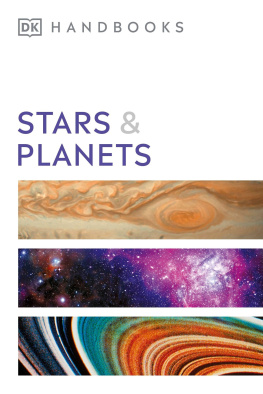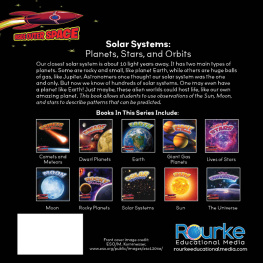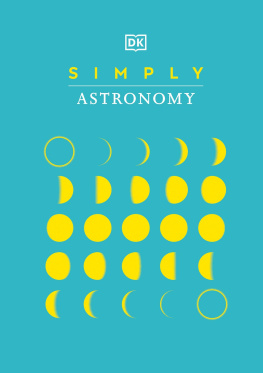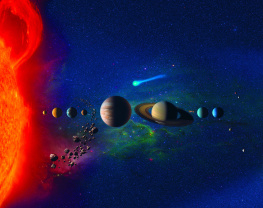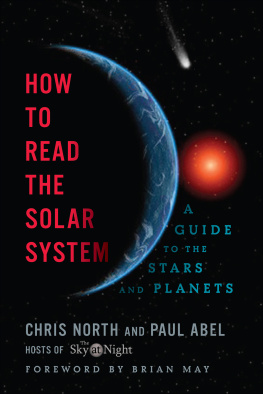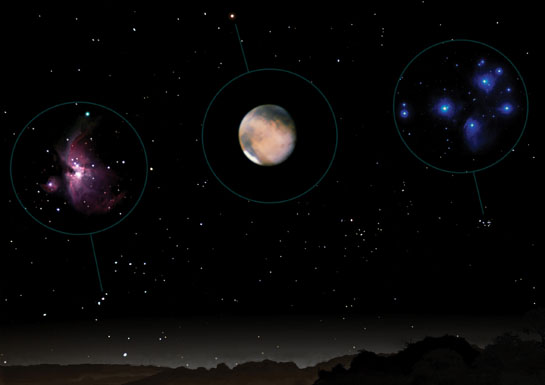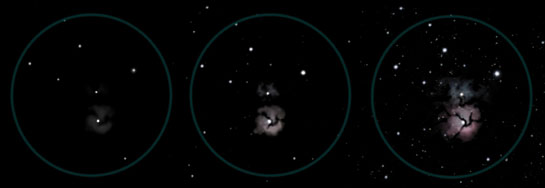THE STAR BOOK
AN INTRODUCTION TO STARGAZING AND THE SOLAR SYSTEM
PETER GREGO
The Black Eye Galaxy (M64) in Coma Berenices is a prominent member of the Coma-Virgo cluster of galaxies.
Introduction
Examples of three celestial objects that can be enjoyed with the unaided eye, binoculars or a telescope: the Orion Nebula (left), a stellar birthplace; Mars (centre); and the Pleiades (right), a cluster of young hot stars.
People have gazed at the starry skies with wonder and awe ever since the first sparks of human consciousness flickered in the minds of our distant ancestors. Astronomy is the oldest of all the physical sciences; records of celestial events go back many thousands of years to the beginnings of the earliest cultures. Celestial cycles the movement of the Sun, the phases of the Moon and the annual seasons with their grand parade of stars and constellations gave humans a practical means of timekeeping; later, the great seafaring civilizations of antiquity learned to navigate by the stars. Things have come full circle; the most accurate clocks we know of are to be found in the regular flashes from exotic stars called pulsars, while above us in orbit GPS satellites enable navigators to pinpoint their position on Earth to within metres.
Seeing the night skies
Theres a great deal to see in the night sky. Whether you use binoculars or a telescope, or even if you have no optical aid at all, there are enough celestial sights to keep anyone enthralled for a lifetime. Stars and constellations are permanent fixtures; others, like the planets, move against the celestial backdrop and appear to change over time. A few phenomena, such as meteors and eclipses, are fleeting but spectacular.
So much can be seen in the night skies without optical aid. Its fascinating to spend time learning the layout of the skies, the positions of the main constellations and the names of the brightest stars essential, even, if you would like to take your enjoyment of astronomy to a higher level. There are advantages to living in an urban area, where sky-glow caused by city lights drowns out all but the brighter stars. Although just a few hundred stars might be seen with the unaided eye from a dark enclave in a city centre, the night sky appears less crowded and the patterns of the main constellations are easier to trace. Under a dark rural sky where several thousand stars can be seen, the heavens can appear so congested with stars that even experienced astronomers can become a little disorientated.
Using binoculars
Eminently portable, with wide fields of view and low magnification, binoculars give unlimited freedom to roam the night skies they are the ideal starter instruments for anyone who is new to stargazing. Binoculars gather more light than the eyes alone and reveal many of the night skys hidden treasures; they also give the startling (although illusory) impression of three dimensions in space. The colours of stars are especially noticeable through binoculars, and many star clusters, nebulae and galaxies, as well as countless glorious starfields, can be viewed with their aid.
The power of binoculars is identified by two figures one denoting their magnification and the other the size of their objective lenses. For example, a 730 binocular the smallest practically useful for stargazing magnifies seven times and has 30mm lenses. Even 730s can show several hundred thousand stars and numerous deep-sky objects, while more than a million stars and thousands of deep-sky wonders can be seen through a large 2080 binocular.
Comparisons of views through different binoculars: the Moon, as seen through 730s (left), 1250s (centre) and 25100s (right).
Using a telescope
With their greater light gathering ability, telescopes deliver detailed, magnified views of the night skies. Innumerable deep-sky treasures can be viewed in detail and wonderful structure is visible on the Moon and planets. Viewed through a telescope, the stars themselves appear brighter but they are so far away that they remain pinpoints of light, regardless of the magnification used.
Spectacular images from the Hubble Space Telescope and a bewildering assortment of satellites and space probes show a magnificently pin-sharp, multicoloured Universe. Its easy to see why some peoples expectations are incredibly high when they put their eye to the telescope eyepiece for the first time. While a great many celestial sights are truly amazing visually, in practical terms much of what the night skies has to offer its Earth-based viewers is relatively faint and requires a degree of informed appreciation. Cosmic colours are generally on the subtle side and the eye has to get used to its own limitations, as well as the limitations of the instrument used and those imposed by the local environment.
The enjoyment, however, is in the self-discovery of the night skies, learning what each celestial object is and where its located in the Universe. The realization that your eyes are receiving rays of light from a distant object that may have set out before you were born, before Rome was built or even before humans evolved on Earth, is truly awe-inspiring.
Comparisons of views through different sized telescopes at the same magnification: the Trifid Nebula, as seen through a 60mm refractor (left), a 200mm Schmidt-Cassegrain (centre) and a 500mm reflector (right).
Celestial Graphics Charting the Stars
In keeping with the deep human desire to find some sort of order in the cosmos, patterns of stars in the night skies were assembled into constellations creatures, objects and symbols outlined by prominent stars in a join-the-dots fashion. Constellations reflected the mythology and lifestyle of each culture that imagined them. Such celestial picture books had more than poetic purposes; agricultural communities used their rising, culmination and setting for timekeeping, while navigators and explorers found them to be useful signposts in the sky.
From the Sumerian and Babylonian civilizations of Bronze Age Mesopotamia arose the origins of the patterns of constellations we recognize today; they defined the ecliptic (the yearly path of the Sun), the 12 divine constellations of the Zodiac along the ecliptic (through which the Moon and planets appear to move), and numerous other constellations that referred to animals and agriculture.
These ancient constellations were later incorporated into works by Eudoxus of Cnidus (


